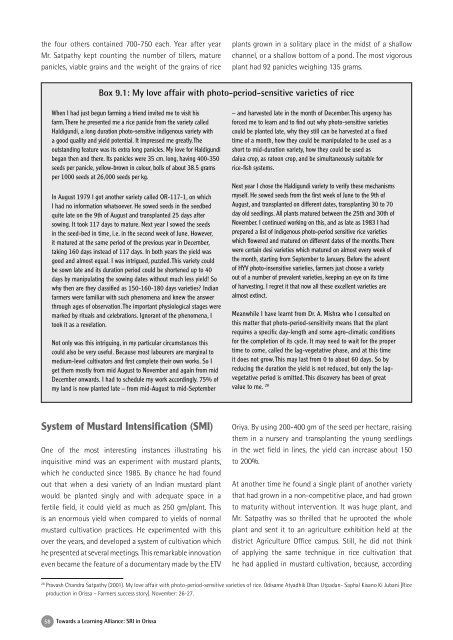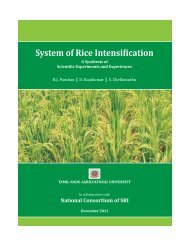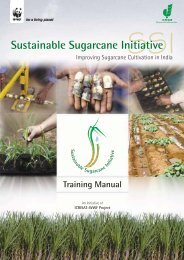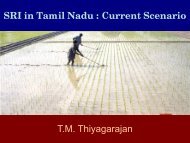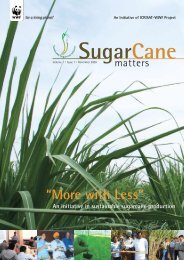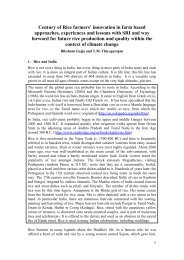SRI in Orissa - Cornell International Institute for Food, Agriculture ...
SRI in Orissa - Cornell International Institute for Food, Agriculture ...
SRI in Orissa - Cornell International Institute for Food, Agriculture ...
You also want an ePaper? Increase the reach of your titles
YUMPU automatically turns print PDFs into web optimized ePapers that Google loves.
the four others conta<strong>in</strong>ed 700-750 each. Year after year<br />
Mr. Satpathy kept count<strong>in</strong>g the number of tillers, mature<br />
panicles, viable gra<strong>in</strong>s and the weight of the gra<strong>in</strong>s of rice<br />
plants grown <strong>in</strong> a solitary place <strong>in</strong> the midst of a shallow<br />
channel, or a shallow bottom of a pond. The most vigorous<br />
plant had 92 panicles weigh<strong>in</strong>g 135 grams.<br />
Box 9.1: My love affair with photo-period-sensitive varieties of rice<br />
When I had just begun farm<strong>in</strong>g a friend <strong>in</strong>vited me to visit his<br />
farm. There he presented me a rice panicle from the variety called<br />
Haldigundi, a long duration photo-sensitive <strong>in</strong>digenous variety with<br />
a good quality and yield potential. It impressed me greatly. The<br />
outstand<strong>in</strong>g feature was its extra long panicles. My love <strong>for</strong> Haldigundi<br />
began then and there. Its panicles were 35 cm. long, hav<strong>in</strong>g 400-350<br />
seeds per panicle, yellow-brown <strong>in</strong> colour, bolls of about 38.5 grams<br />
per 1000 seeds at 26,000 seeds per kg.<br />
In August 1979 I got another variety called OR-117-1, on which<br />
I had no <strong>in</strong><strong>for</strong>mation whatsoever. He sowed seeds <strong>in</strong> the seedbed<br />
quite late on the 9th of August and transplanted 25 days after<br />
sow<strong>in</strong>g. It took 117 days to mature. Next year I sowed the seeds<br />
<strong>in</strong> the seed-bed <strong>in</strong> time, i.e. <strong>in</strong> the second week of June. However,<br />
it matured at the same period of the previous year <strong>in</strong> December,<br />
tak<strong>in</strong>g 160 days <strong>in</strong>stead of 117 days. In both years the yield was<br />
good and almost equal. I was <strong>in</strong>trigued, puzzled. This variety could<br />
be sown late and its duration period could be shortened up to 40<br />
days by manipulat<strong>in</strong>g the sow<strong>in</strong>g dates without much less yield! So<br />
why then are they classified as 150-160-180 days varieties? Indian<br />
farmers were familiar with such phenomena and knew the answer<br />
through ages of observation. The important physiological stages were<br />
marked by rituals and celebrations. Ignorant of the phenomena, I<br />
took it as a revelation.<br />
Not only was this <strong>in</strong>trigu<strong>in</strong>g, <strong>in</strong> my particular circumstances this<br />
could also be very useful. Because most labourers are marg<strong>in</strong>al to<br />
medium-level cultivators and first complete their own works. So I<br />
get them mostly from mid August to November and aga<strong>in</strong> from mid<br />
December onwards. I had to schedule my work accord<strong>in</strong>gly. 75% of<br />
my land is now planted late – from mid-August to mid-September<br />
– and harvested late <strong>in</strong> the month of December. This urgency has<br />
<strong>for</strong>ced me to learn and to f<strong>in</strong>d out why photo-sensitive varieties<br />
could be planted late, why they still can be harvested at a fixed<br />
time of a month, how they could be manipulated to be used as a<br />
short to mid-duration variety, how they could be used as<br />
dalua crop, as ratoon crop, and be simultaneously suitable <strong>for</strong><br />
rice-fish systems.<br />
Next year I chose the Haldigundi variety to verify these mechanisms<br />
myself. He sowed seeds from the first week of June to the 9th of<br />
August, and transplanted on different dates, transplant<strong>in</strong>g 30 to 70<br />
day old seedl<strong>in</strong>gs. All plants matured between the 25th and 30th of<br />
November. I cont<strong>in</strong>ued work<strong>in</strong>g on this, and as late as 1983 I had<br />
prepared a list of <strong>in</strong>digenous photo-period sensitive rice varieties<br />
which flowered and matured on different dates of the months. There<br />
were certa<strong>in</strong> desi varieties which matured on almost every week of<br />
the month, start<strong>in</strong>g from September to January. Be<strong>for</strong>e the advent<br />
of HYV photo-<strong>in</strong>sensitive varieties, farmers just choose a variety<br />
out of a number of prevalent varieties, keep<strong>in</strong>g an eye on its time<br />
of harvest<strong>in</strong>g. I regret it that now all these excellent varieties are<br />
almost ext<strong>in</strong>ct.<br />
Meanwhile I have learnt from Dr. A. Mishra who I consulted on<br />
this matter that photo-period-sensitivity means that the plant<br />
requires a specific day-length and some agro-climatic conditions<br />
<strong>for</strong> the completion of its cycle. It may need to wait <strong>for</strong> the proper<br />
time to come, called the lag-vegetative phase, and at this time<br />
it does not grow. This may last from 0 to about 60 days. So by<br />
reduc<strong>in</strong>g the duration the yield is not reduced, but only the lagvegetative<br />
period is omitted. This discovery has been of great<br />
value to me. 28<br />
System of Mustard Intensification (SMI)<br />
One of the most <strong>in</strong>terest<strong>in</strong>g <strong>in</strong>stances illustrat<strong>in</strong>g his<br />
<strong>in</strong>quisitive m<strong>in</strong>d was an experiment with mustard plants,<br />
which he conducted s<strong>in</strong>ce 1985. By chance he had found<br />
out that when a desi variety of an Indian mustard plant<br />
would be planted s<strong>in</strong>gly and with adequate space <strong>in</strong> a<br />
fertile field, it could yield as much as 250 gm/plant. This<br />
is an enormous yield when compared to yields of normal<br />
mustard cultivation practices. He experimented with this<br />
over the years, and developed a system of cultivation which<br />
he presented at several meet<strong>in</strong>gs. This remarkable <strong>in</strong>novation<br />
even became the feature of a documentary made by the ETV<br />
Oriya. By us<strong>in</strong>g 200-400 gm of the seed per hectare, rais<strong>in</strong>g<br />
them <strong>in</strong> a nursery and transplant<strong>in</strong>g the young seedl<strong>in</strong>gs<br />
<strong>in</strong> the wet field <strong>in</strong> l<strong>in</strong>es, the yield can <strong>in</strong>crease about 150<br />
to 200%.<br />
At another time he found a s<strong>in</strong>gle plant of another variety<br />
that had grown <strong>in</strong> a non-competitive place, and had grown<br />
to maturity without <strong>in</strong>tervention. It was huge plant, and<br />
Mr. Satpathy was so thrilled that he uprooted the whole<br />
plant and sent it to an agriculture exhibition held at the<br />
district <strong>Agriculture</strong> Office campus. Still, he did not th<strong>in</strong>k<br />
of apply<strong>in</strong>g the same technique <strong>in</strong> rice cultivation that<br />
he had applied <strong>in</strong> mustard cultivation, because, accord<strong>in</strong>g<br />
28<br />
Pravash Chandra Satpathy (2001). My love affair with photo-period-sensitive varieties of rice. Odisame Atyadhik Dhan Utpadan- Saphal Kisano Ki Jubani [Rice<br />
production <strong>in</strong> <strong>Orissa</strong> – Farmers success story]. November: 26-27.<br />
58<br />
Towards a Learn<strong>in</strong>g Alliance: <strong>SRI</strong> <strong>in</strong> <strong>Orissa</strong>


